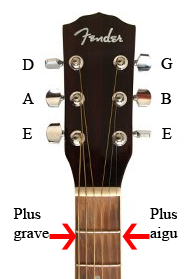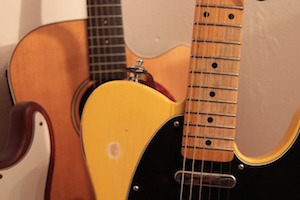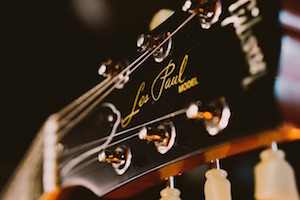All musical instruments need to be tuned on a regular basis. This is true for guitars, but also for pianos, harps, violins, etc. Every single guitar string is under a tension that ranges from 15 to 20 pounds, and that energy tends to dissipate over time, making the guitar out of tune.
On top of that, humidity and temperature variations have an influence on wood and make it swell or shrink, which also leads to small changes in the instrument’s setup. This is why a guitar should always be tuned before it’s played.
A440
A440 is a reference pitch used by all musicians and available on all tuners. It is also the note given by most tuning forks when they’re hit and start to ring.
To tune a guitar string with such a reference, you have to turn the corresponding mechanic (the knob in which the string is eventually wrapped at the top of the neck) so that the note A on the string matches the external reference. This might be hard to do when starting out, this is why I would advise getting a tuner instead. But it is a process worth understanding.
A guitar’s strings

The vast majority of guitars use six strings that are tuned in standard E tuning. Each string set is made out of three low strings, and three high strings. The lowest string is E, which means that when it is played without any left hand fretting (we say ‘open’), the note produced is an E. Here’s the list of strings in the same order as on your guitar:
- low E
- A
- D
- G
- B
- high E
The notes on the neck
Once a note on your guitar is aligned with A440 (the A at the 5th fret of the high E string for instance), then the whole string will be in tune, no matter whether you’re playing a D at the 10th fret, a C# at the 9th fret, or an F at the first fret. You’ll therefore be able to use this string as a reference to tune other strings against, the same way you used A440 as a reference to tune the first string.

The classical approach
The classical approach is indeed exactly about tuning the A on the 5th fret of the high E string with a reference A. Then, the high E string is played open, and it should sound the same as the E at 5th fret of the B string.

Once the B string is in tune, it should be played open and compared to the B at the 4th fret of the G string:

Now let’s play the open G string and match that to the G at the 5th fret of the D string:

Next, let’s match the D on the 5th fret of the A string with the open D string:

Finally, let’s match the note A on the 5th fret of the E string with the open A string:

Explication vidéo
Any question?
Congratulations, you now know how to tune a guitar! Although it can be frustrating for a guitar beginner, it is an excellent exercise in order to improve your musical ear. To tune faster and with more precision, you should look into purchasing a tuner.



